


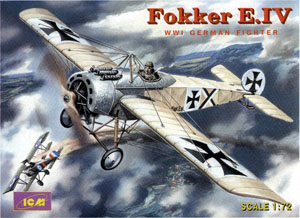 ICM
vs. MAC
ICM
vs. MAC
1/72 Fokker E.IV
By Matt Bittner
History
The Fokker E.IV was a result of trying to increase performance of the E.III. It was thought that just by adding another gun (or two, in some cases) as well as a larger engine that performance and fighting ability could be increased. However, the E.III was as optimal as the Fokker Eindecker could get. By adding the extra gun (or two) and the bigger engine only meant poorer performance especially in regards to maneuverability. There was also a problem with the synchronizer gear in the two (or three) gun arrangement. All in all with the problems associated with the E.IV only 29 examples made it to the front.
The Kits
The MAC E.IV consists of 28 injected molded parts, a photoetch fret of 6 parts, and a clear film representing the instrument panel. Decals are for three specific schemes: Wintgens, Boelcke and an indistinct one with a serial of 127/15. They also contain extra markings for some unknown examples.
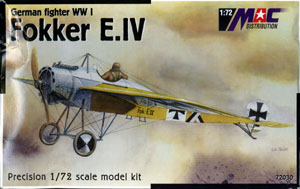 The
ICM E.IV consists of 45 injected parts and 2 clear pieces. The only scheme
on the decal sheet is for Boelcke's machine, even though the box top shows
Wintgens' machine.
The
ICM E.IV consists of 45 injected parts and 2 clear pieces. The only scheme
on the decal sheet is for Boelcke's machine, even though the box top shows
Wintgens' machine.
The following comparison was done using the only known 1/72nd scale plans of the Fokker E.IV, which were published in the July 1983 issue of Scale Models (SM).
Fuselage Comparison
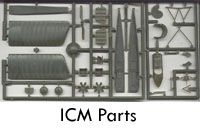 Overall
the ICM fuselage is much nicer, even though it is molded in four parts
- left and right sides, top and the separate, forward "hump". This means
ICM could easily do an E.III by replacing the "hump", cowl and engine.
Overall
the ICM fuselage is much nicer, even though it is molded in four parts
- left and right sides, top and the separate, forward "hump". This means
ICM could easily do an E.III by replacing the "hump", cowl and engine.
The "hump" in front of the cockpit - which gave the E.IV its distinctive shape - is more accurate in the ICM kit than the MAC. The MAC slopes down too quickly directly in front of the cockpit. ICM's "hump" is separate, whereas MAC has molded theirs in-situ with the rest of the fuselage.
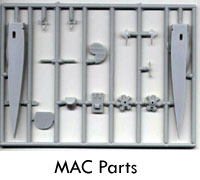 Interior
wise, the ICM is also nicer, although both have different representations
for the "instrument panel". The MAC consists of p/e and "film", while
ICM's is a decal. However, the differences don't stop there. Detail wise
the MAC consists of three "dials", while the ICM's decal is quite busy.
I'm not sure which one is more accurate. The ICM kit has molded in cockpit
detail, while the MAC does not. In addition, the inside of the MAC fuselage
halves will have to be thinned and "squared off"; out of the box it unfortunately
has a rounded shape to the insides.
Interior
wise, the ICM is also nicer, although both have different representations
for the "instrument panel". The MAC consists of p/e and "film", while
ICM's is a decal. However, the differences don't stop there. Detail wise
the MAC consists of three "dials", while the ICM's decal is quite busy.
I'm not sure which one is more accurate. The ICM kit has molded in cockpit
detail, while the MAC does not. In addition, the inside of the MAC fuselage
halves will have to be thinned and "squared off"; out of the box it unfortunately
has a rounded shape to the insides.
Fuselage/cockpit winner is definitely ICM.
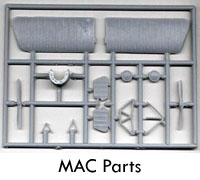 Wing
Comparison
Wing
Comparison
According to the SM plans both wings are short in span 1mm; however, MAC provides the "riblets" in between the normal ribs. Point to MAC. On the other hand, ICM molded in the location for the compass - and include a piece of clear plastic to represent this compass. Point to ICM. Regardless, both wings suffer from large ribs and thick trailing edges. All in all both kits are tied in the wing department.
Tail Surfaces
Both kits suffer from too small tail surfaces. The ICM tailpieces show
a little more finesse and are thinner - but one of my horizontal tails
is short-shot. Plus, the ICM rudder comes closest to representing the
distinctive shape of the Fokker Eindecker rudder. Again, ICM wins in the
tail surfaces departments, 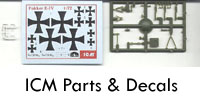 especially
since they provide a separate "tube" that the horizontal tail pieces slot
into, which gets installed as the fuselage halves are put together. Huge
score for ICM.
especially
since they provide a separate "tube" that the horizontal tail pieces slot
into, which gets installed as the fuselage halves are put together. Huge
score for ICM.
Cowl and Engine
The MAC cowl is overly thick, has a lot of flash in and around the cooling holes, and is missing the distinctive brace at the front of the cowl. The engine is nothing but a blob of plastic, only representing an engine in the shape area.
The ICM cowl is nicely cast, has very little flash and is quite thin. The engine is very nice, accurate and molded in two halves to ensure the detail is consistent across cylinders.
ICM definitely excels in this area.
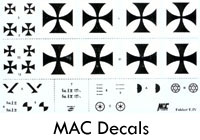 Smaller
Detail Parts
Smaller
Detail Parts
As far as the smaller details are concerned, ICM wins hands down. All struts and the like are very fine and relatively too scale. The landing gear area is a piece of art and is relatively complete. The MAC struts are extremely clunky and thick, and are missing some distinctive items that make up their uniqueness.
Unfortunately the ICM guns are much too thin and will need to be replaced. The MAC guns consist of the barrel only, which gets glued into an opening that "kind of" represents the rest of the gun.
Kit Instructions
Instruction wise, it's split 50/50. ICM's are better laid out and more "professionally" drawn, but lack rigging information. MAC comes not only with rigging drawings, but what appear to be scale drawings as well. In addition their scheme drawings are small pieces of art. ICM's scheme drawing is just - well - there.
Conclusion
To me it's obvious that ICM is the comparison winner. MAC is just too "clunky" while ICM's E.IV shows more finesse. In fact, I can see why they split the fuselage into three pieces - the detail is better with it molded this way. In addition, you can pick up two ICM E.IVs for the cost of one MAC. ICM offers excellent value for the money.

Previous: Contents







